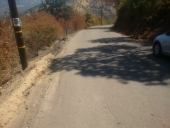I have doing something similar as I've been clearing my little acreage. I've just been creating fairly big piles of old blackberry canes, piles of greenbriar I've been yanking from trees, tree branches, trees I've cut down to clear my fence line...and crummy, non-native trees (pines in my locale). I've also been clearing sumacs and adding them to the piles. The piles have decreased in volume some, but I keep adding to them yearly. So far, blackberry and elderberry have colonized the fringes, along with white germander, sumac and maypops. I have been doing all of this by hand, but my extemporaneous "hugel" pile is several hundred feet long, and averages about 4-ft in height. I have no plans for plantings on or near this, but I like that blackberry has colonized it.



